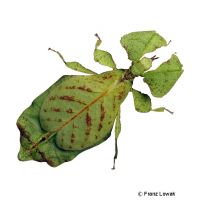Gray's Leaf Insect (Phyllium bioculatum)
| Gray's Leaf Insect Phyllium bioculatum | |
|---|---|
| Name | Gray's Leaf Insect |
| Name Lat. | Phyllium bioculatum |
| Family | Leaf Insects |
| Family lat. | Phylliidae |
| Order | Phasmids |
| Order lat. | Phasmatodea |
| Origin | South and Southeast Asia |
| Habitat | Forest |
| Diet | Fresh rose-family leaves |
| Humidity | 60-70 % |
| Behavior | Nocturnal, peaceful |
| Keeping | Pair, group |
| Care Level | Moderate |
| Housing | Semi-humid terrarium |
| Breeding | Moderately difficult |
| Life Span | 1-6 months |
| Protection | No |
| Metric Units | |
| Size | 5-9 cm |
| Temperature Day | 25-30 °C |
| Temperature Night | 20-22 °C |
| Housing Size | 40 x 40 x 50 cm |
| US Units | |
| Size | 2"-3.5" |
| Temperature Day | 77-86 °F |
| Temperature Night | 68-72 °F |
| Housing Size | 15" x 15" x 20" |
Distribution and habitat
The distribution range of the nocturnal walking leaves is Borneo, Sumatra and Java in Southeast Asia, as well as Ceylon, Mauritius and the Seychelles, where they live well camouflaged in the dense vegetation of tropical mountain forests
Maintenance
We recommend an insectarium of at least 40 x 40 x 50 cm (L x W x H) for a small group (2-3 pairs), which should be placed in a quiet place without sunlight.
The most suitable is an insectarium with a cover made of gauze or a fine metal grid, which should be placed in a quiet, place without sunlight.
They need climbing facilities, such as cork back walls, twigs and branches, which also serve as food plants. In order to keep them fresh longer, they should be given in narrow-necked, well-sealed (danger of drowning), stable containers (e.g. vase) with frequent water changes. Furthermore a small, flat drinking vessel with water gel or a cotton trough. Suitable substrate is terrarium humus or a soil-sand mixture covered with moss, which should always be kept slightly moist. Several times a week the insectarium should be finely sprayed with water inside (humidity), but a rain or mist system is better. Waterlogging should be avoided at all costs. Good ventilation (fan) is especially important
| Temp. day: 25-30 °C | Temp. night: 20-22 °C | Humidity: 60-70 |
The lighting duration should be 10-12 hrs. Light sources that also produce the necessary heat are ideal.
Diet
The food supply consists of fresh leaves of blackberry, maple, guava and ivy (Hedera helix) and leaves of ferns. Leaves of other roses and rose plants, such as red and hawthorn, raspberry, currant, wild rose, honeysuckle (Lonicera nitida), etc., as well as the leaves of beech, oak, linden, hazel or sweet chestnut are also accepted in different individual ways. Blackberries are ideal as food in winter, as they remain green. Eaten branches, dried or spoiled foliage must be removed regularly
Only unsprayed leaves should be offered, as animals do not tolerate chemical pollution. A regular and varied diet promotes the well-being of the animals.
Reproduction and breeding
Adult males are smaller than females, have functional wings, and their antennae are longer and thicker.
The animals can reproduce sexually or asexually by virgin reproduction (parthenogenesis). If males are present, mating occurs. The female lays small eggs resembling seeds on the ground. Incubation is best at 25-28 °C and high humidity (70-80%). The larvae hatch after 4-6 months. Particularly tender leaves should be offered as initial food.
After the imaginal moult the males live up to 10 weeks, females can live for about 6 months afterwards.
Important
Depending on the origin of the animals, there are many different variants, which differ in color, drawing and shape. With coloring and physique, but also by rocking movement, the animals imitate foliage leaves (leaf mimesis) to achieve the most perfect camouflage from predators
Before purchasing, an insectarium should be prepared that meets the species-specific needs. Good ventilation without drafts is necessary, as well as equipment for measuring temperature and humidity. The lighting must correspond to the day-night rhythm appropriate for the species and must be installed in such a way that the animals cannot injure themselves. The insectarium should be locked in such a way that neither unauthorized persons can open it nor the animals can escape. Special attention must be paid to thorough hygiene and contamination must be removed regularly.
Further literature can be found in your pet store.
References
Text: Serena Werle; Image: Franz Lowak
Source: SEILER, BRADLER & KOCH (2000): Phasmiden, bede-Verlag; ENGELMAN & LANGE (2011): Zootierhaltung - Tiere in menschlicher Obhut: Wirbellose, Verlag Harri Deutsch
